#Château de Bois-Préau
Text


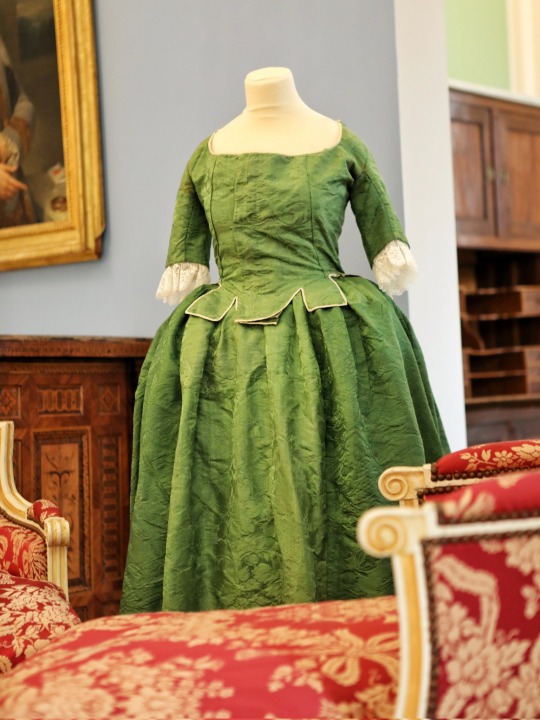
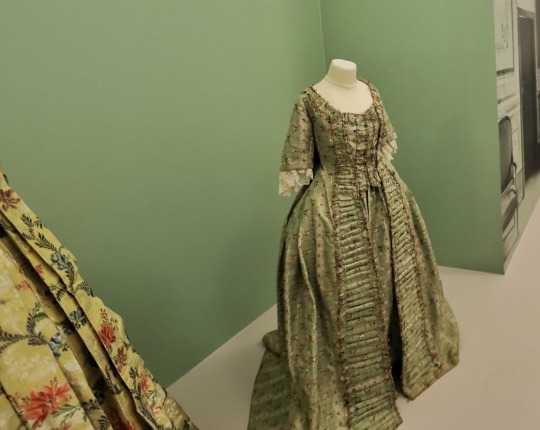
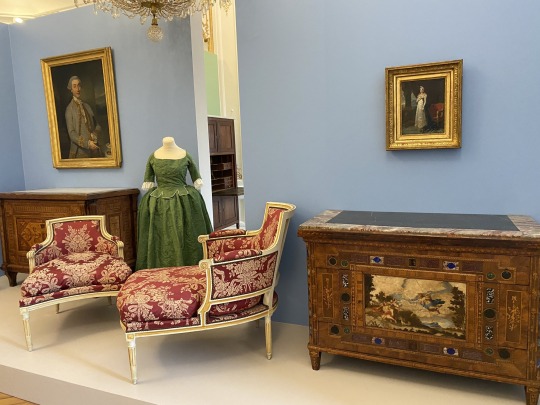
18th century dresses at Malmaison in France. Current exhibition from the Château de Bois-Préau: 1769, Corsica at the Birth of Napoleon Bonaparte
For several years, the National Museum of the House of Bonaparte in Ajaccio, Napoleon's birthplace where his family lived since the end of the 15th century, has been exploring with talent the history of Corsican society, the architecture of patrician houses, their furnishings and the art of living in Corsica in the 18th century.
For the first time, the synthesis of this work will be presented at the National Museum of châteaux des Malmaison and Bois-Préau on the ground floor of the newly restored Château de Bois-Préau.
#dresses#18th century#1700s#1700s fashion#18th century fashion#rococo#Corsica#corse#La corse#malmaison#château de malmaison#Château de Bois-Préau#1700s dresses#18th century dresses#18th century dress#robe a la francaise#robe à la française#sack-back gown#18th century gown#gown#1700s gown#Paris#Ajaccio#Bonaparte#fashion#history of fashion#fashion history#France#Napoleon#napoleon bonaparte
153 notes
·
View notes
Photo
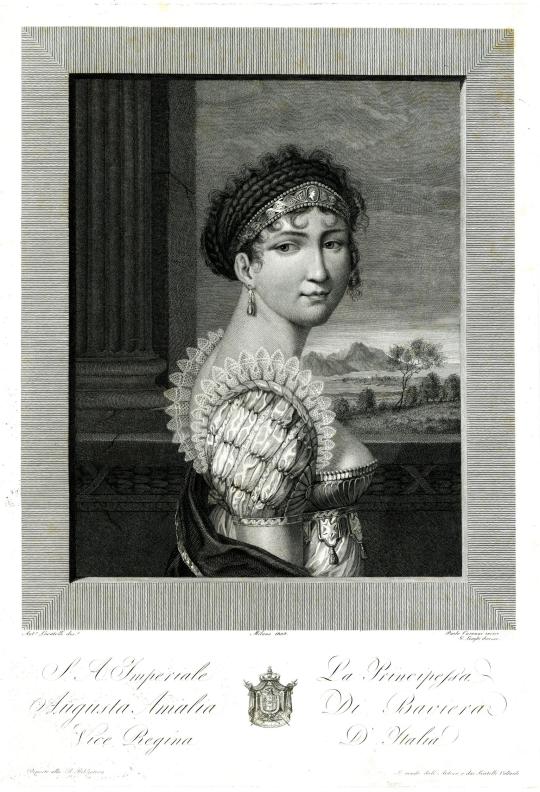
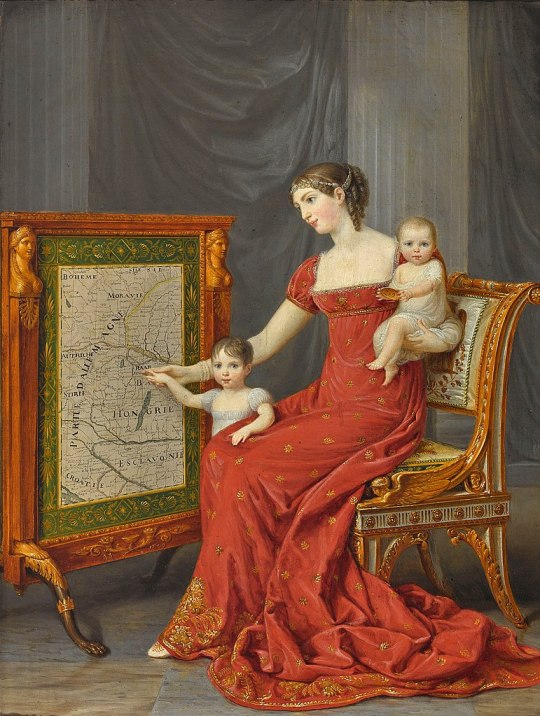
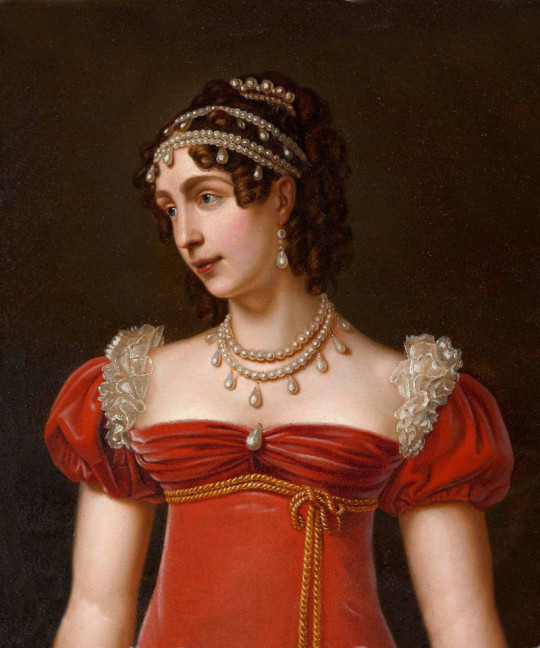



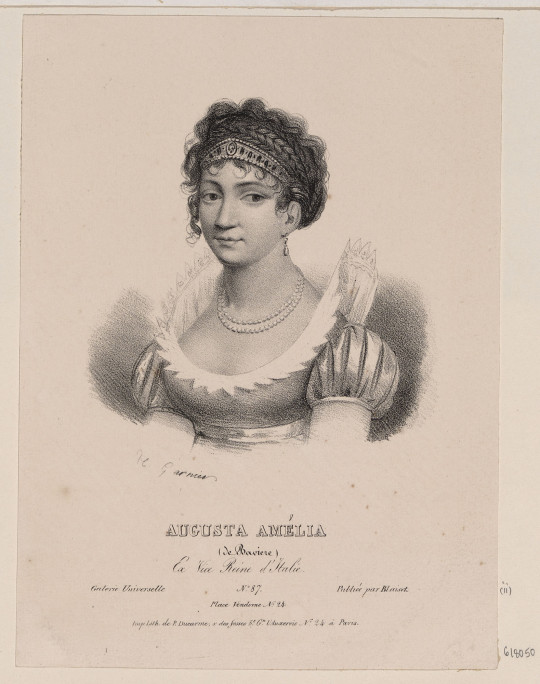


Augusta Amalia of Bavaria - She fell in love, but Napoléon intervened and she had to marry 1808 Empress Josephine’s son Eugéne to spare Bavaria from imperial wrath.
Top left: Augusta Amalia of Bavaria, bust length, wearing tiara with pearls, pearl earring, and low dress by Paolo Caronni and/or Giuseppe Longhi (British Museum). From their Web site 1705X2000 @300 2.1Mj.
Top right: 1809 Auguste Amalie de Beauharnais, Vizekönigin von Italien, mit ihren Töchtern Josephine und Eugenie by Andrea Appiani (location ?). From Wikimedia via pinterest.com/marcellagarsia/fashion-in-painting-xix-secolo/1800s/ 771X1023 @72 378kj.
Second row: 1810 Augusta Amalia Ludovika von Bayern, Duchess of Leuchtenberg by ? (location ?). From napoleondidthat.tumblr.com/post/122145342551/augusta-amalia 800X960 @72 270kj.
Third row left: 1814 Princess Augusta Amalia of Bavaria as a Vice-queen of Italy by ? (location ?). From csfd.cz/film/1010768-napoleons-erben-in-bayern-die-herzoge-von-leuchtenberg/galerie/?page=2 1268X1766 @144 4Mp.
Third row right: ca. 1815 Augusta-Amélie de Bavière by François Pascal Simon Gérard (Versailles). From art.rmngp.fr/en/library/artworks; erased cracks & spots w Pshop & enlarged 25% 609X936 @96 140kj.
Fourth row: ca. 1816 Auguste Amalie de Baviere by Joseph Karl Stieler (Château de Malmaison - Rueil-Malmaison, Île-de-France, France). From Wikinedia; erased cracks & flaws and fixed edges w Pshop 725X925 @72 1.3Mp.
Fifth row left: 1820 (or later) Augusta of Bavaria, Duchess of Leuchtenberg by Garnier (Royal Collection RCIN 618050), From their Web site 1579X2000 @300 956kj.
Fifth row right: 1824-1825 Auguste-Amélie de Bavière by Joseph Karl Stieler (Châteaux de Malmaison et Bois-Préau - Rueil-Malmaison, Île-de-France, France). From Wikimedia 1006X1254 @72 260kj.
Sixth row: ca. 1825 Auguste Amalie, Princess of Bayern by Joseph Karl Stieler (auctioned by Ketterer Kunst) From pinterest.com/AlexyMet/ritratti-aristocratici-eleganti/; fixed flaws and spots throughout image with Photoshop. 3003X4002 @300 4.1Mj. This dress is more in keeping with the 1830s than the 1820s.
#Empire fashion#French restoration era fashion#1800s fashion#1810s fashion#1820s fashion#1830s fashion#Augusta Amalia of Bavaria#curly hair#tiara#square décolletage#neckline ruff#Empire waistline#close skirt#quarter length close sleeves#Paolo Caronni#Andrea Appiani#Giuseppe Longhi#square neckline#hair jewelry#waist band#François Pascal Simon Gérard#Joseph Karl Stieler#feathered hat#high neckline#slashing#long sleeves#Garnier#scoop neckline#turban#robes
40 notes
·
View notes
Text
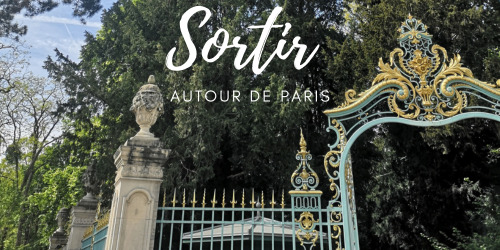
Sortir autour de Paris
Si vous avez prévu de venir passer un long séjour sur Paris cela peut-être l'occasion de faire des excursions en banlieue afin de découvrir les nombreux sites franciliens dignes d'intérêt.
Facilement accessibles par la voiture ou par les transports en commun ils vous permettront de vous évader pour quelques heures, voire pour une journée, du tumulte parisien.
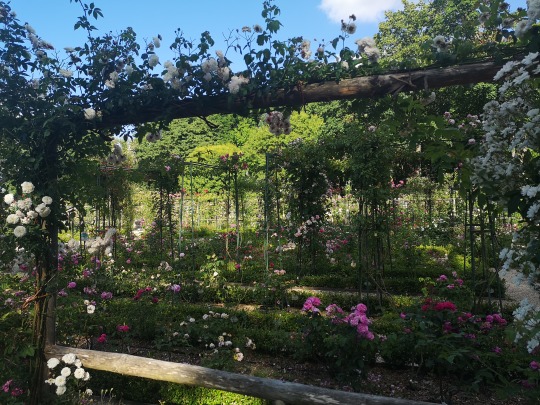
Les parc et les jardins
L'Ile-de-France a la chance de compter de nombreux espaces verts, qu’ils s'agissent de parcs de châteaux, de jardins spécialisés, de bases de loisirs ou de forêts protégées ou squares urbains, cette diversité agricoles permet à tous de s'offrir des escapades au calme dans la nature.
Dans la Seine-et-Marne : jardins du château de Fontainebleau, jardin de Vaux-Le-Vicomte, jardins de Champs-sur-Marne, roseraie de Provins, domaine de la Grange Prévôté, jardin-pépinière du Point du Jour, jardin de sculptures de la Dhuys, parc de Rentilly, jardin Bourdelle, parc des Capucins, jardin Bossuet, jardin du cloître de Donnemarie-Dontilly, parc Debreuil, parc des Frênes à Montévrain, parc naturel du Pâtis, parc de la Fontaine aux Pigeons
Dans le Val-de-Marne : parc et roseraie de L’Haÿ-les-Roses, parc des Lilas, parc du Plateau à Champigny, espace naturel de la Pierre-Fitte, parc des Hautes-Bruyères, parc du Rancy, parc de la Saussaie, jardins de Chevilly, le parc des Marmousets, parc Watteau, le parc Dupeyroux, terrasse panoramique de Chennevières, parc de la plage bleue, arboretum de Joinville, parc du Morbras, bois de Vincennes et parc floral, jardin d'agronomie tropicale, parc des Cormailles, parc du Coteau
Dans le Val-d’Oise : Jardins des 5 sens à Pontoise, parc de Marcouville, parc de l’abbaye de Maubuisson, parc du château d’Ecouen, parc de l’abbaye de Royaumont, parc du château de Stors, jardins du château d’Ambleville, domaine de Villarceaux , parc du château de Champlâtreux, Jardin Japonais (Aincourt)
Dans les Yvelines : château de Saint-Germain-en-Laye, Domaine du trianon et Hameau de Marie-Antoinette, Arboretum de Chèvreloup, domaine national de Rambouillet, domaine de Marly-le-Roi, abbaye des Vaux de Cernay , château de Dampierre-en-Yvelines, Serres d'Auteuil
Dans les Hauts-de-Seine : domaine de Sceaux, domaine de Saint-Cloud, Bois de Boulogne et Parc de Bagatelle, jardins d'Albert Kahn, parc Edmond de Rothschild à Boulogne, Parc de l'Amitié, Parc des Impressionnistes, parc du château de la Malmaison, parc du Bois-Préau et domaine de la Malmaison, Jardin japonais d'Ichikawa, arboretum de la Vallée-aux-Loups
Dans la Seine-Saint-Denis : parc Georges-Valbon, parc du Sausset, Ile-Saint-Denis, parc de la Poudrerie, parc des Docks, parc de la Bergère, parc de la Fosse-maussoin, parc Jean Moulin, parc de la Haute-Ile, forêt de Bondy, bois de Bernouille, serre Wangari, parc Ballanger,j parc de Villetaneuse
Dans l’Essonne : jardin de Cocteau, jardin de la Chapelle Saint-Blaise, parc du Gâtinais, domaine de Chamarande, parc du château de Courances, domaine de Courson, arboretum de Vilmorin, domaine de Beauregard, Jardin botanique d'Orsay

Les châteaux et les domaines
L'Ile-de-France a la chance, grâce à son riche passé, d'héberger un impressionnant patrimoine. De nombreux châteaux et domaines se situent ainsi dans les divers départements, offrant un cadre magnifique pour des sorties culturelles. Ces visites historiques sauront vous dépayser et vous feront découvrir une autre facette de la région parisienne.
Les châteaux : Fontainebleau, Ferrières, La Roche-Guyon, Vaux-Le-Vicomte, Saint-Germain-en-Laye , Chantilly, Malmaison, Maisons-Laffitte, Champs-sur-Marne, Blandy-Les-Tours, Breteuil, Auvers-sur-Oise, Courances, Vincennes, Rambouillet, Monte-Cristo, Saint-Jean de Beauregard
Les domaines : Sceaux, Courson, Chamarande, Grosbois, Villarceaux
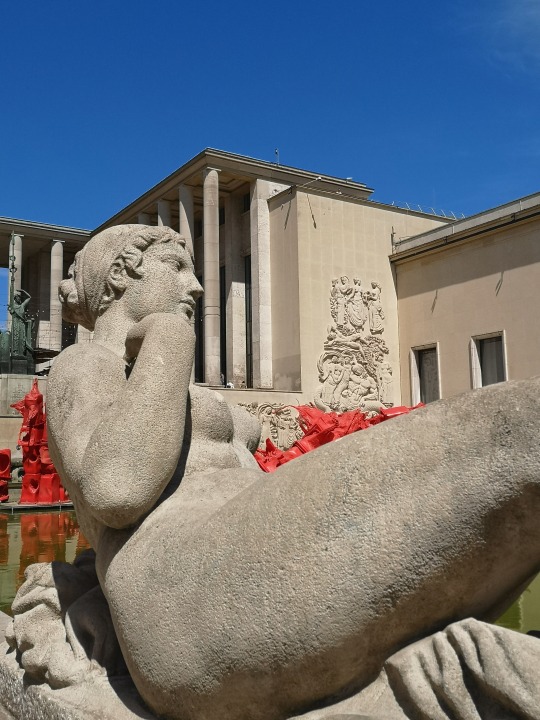
Les musées et les galeries
Si Paris reste la ville accueillant le plus grand nombre de musées en Ile-de-France les communes alentours ne sont pas en reste et détiennent, pour certaines, de remarquables collections. Des expositions temporaires viennent compléter cette offre artistique au fil des saisons, permettant de renouveler le plaisir de visiter ces lieux de culture.
Les musées d'Histoire : Musée Napoléon, musée de la Préhistoire, musée d'archéologie Nationale, Albert Kahn (Boulogne-Billancourt), Années 30 (Boulogne-Billancourt), Air et Espace (Le Bourget), Histoire Vivante (Montreuil-sous-Bois), Memorial de la Shoah (Drancy), Résistance Nationale (Champigny-sur-Marne), Archéa (Louvres), Archéologique du Val d'Oise (Guiry-en-Vexin), Histoire urbaine et sociale (Suresnes)
Les musées d'art : musée Bossuet (Meaux), École de Barbizon, , grande guerre (Meaux), Art naïf (Vicq), Fournaise (Chatou), Jouet (Poissy), Lambinet (Versailles), Cité de la Céramique (Sèvres), Art et Histoire Louis-Senlecq (L'Isle-Adam), Musée National de la Renaissance (Ecouen), Étampes, Le Cube (Issy-les-Moulineaux), le MACVAL
Les musées d'artistes : Maison Elsa Triolet-Aragon (Saint-Arnoult-en-Yvelines), Maurice Denis (Saint-Germain-en-Laye), Zola-Dreyfus (Médan), Photographie (Bièvres), Maison Jean Cocteau (Milly-la-Forêt), Paul Delouvrier (Évry), Propriété Caillebotte (Yerres), Maison de Châteaubriand (Châtenay-Malabry), Villa des Brillants (Meudon), Adrien Mentienne (Bry-sur-Marne), Fragonard (Maisons-Alfort), MAC/VAL (Vitry-sur-Seine), Maison d'art (Créteil), Villa Médicis (La Varenne-Saint-Hilaire), Maison Robert Doisneau (Gentilly), Maison Van Gogh (Auvers-sur-Oise), Tavet Delacour (Pontoise), Camille Pissarro (Pontoise)
crédits photos @lilstjarna
3 notes
·
View notes
Link
Just in case somebody happens to plan a trip to Paris right now and happens to go to Malmaison: They actually have an exposition on Eugène there right now.
5 notes
·
View notes
Photo

Upcoming 2020 Exhibitions
We’re pleased to announce a selection of upcoming 2020 exhibitions. This winter, we welcome back our iconic Kehinde Wiley painting Napoleon Leading the Army over the Alps (2005), which for the first time at the Brooklyn Museum will be presented in dialogue with its early nineteenth-century source painting, Jacques-Louis David’s Bonaparte Crossing the Alps (1801). We also look at our collection from new perspectives with focused exhibitions that present historical works through a contemporary, multifaceted lens. Out of Place: A Feminist Look at the Collection examines nearly 50 collection works using an intersectional feminist framework. Climate in Crisis: Environmental Change in the Indigenous Americas is an installation of the Museum’s Arts of the Americas collection which reconsiders indigenous art from the perspective of the prolonged and ongoing impact of climate change and colonization. Contemporary artist and MacArthur Fellowship recipient Jeffrey Gibson mines our collection and archives to examine collecting practices and reinterpret historical representations of indigenous communities. We also present African Arts—Global Conversations, a cross-cultural exhibition pairing diverse African works with collection objects made around the world, and Striking Power: Iconoclasm in Ancient Egypt, which examines the damage to sculptures and reliefs in ancient Egypt as a way of also exploring twenty-first-century concerns and struggles over public monuments and the destruction of antiquities.
In March, we celebrate the iconic history and trailblazing aesthetics of Studio 54 in a special exhibition featuring never-before-seen archival materials, video, photography, fashion, and more. We will also present the first solo museum exhibition dedicated to Brooklyn-based photographer John Edmonds, winner of our inaugural UOVO Prize for an emerging Brooklyn artist. And in the fall of 2020, we are proud to mount the first career retrospective of the work of Lorraine O’Grady, one of the most significant figures in contemporary performance, conceptual, and feminist art.
“We’re thrilled to present a roster of exhibitions next season that are in conversation with our collection in fresh and exciting ways,” says Anne Pasternak, Shelby White and Leon Levy Director, Brooklyn Museum. “As an encyclopedic museum, we’re always looking for new ways to examine our collection and open it up to include narratives that have historically been left out of the canon. In 2020, we’re committed to exhibitions that do just that: telling stories that are rarely told, through the eyes of contemporary artists.”

Jacques-Louis David Meets Kehinde Wiley
January 24–May 10, 2020
Morris A. and Meyer Schapiro Wing, 4th Floor
This exhibition brings an iconic painting from our collection—Kehinde Wiley’s Napoleon Leading the Army over the Alps (2005)—into dialogue with its early nineteenth-century source painting, Jacques-Louis David’s Bonaparte Crossing the Alps (1801). The two paintings, displayed together for the very first time, are on view in consecutive exhibitions at the Château de Malmaison from October 9, 2019, to January 6, 2020, and at the Brooklyn Museum from January 24 to May 10, 2020. This focused exhibition questions how ideas of race, masculinity, representation, power, heroics, and agency play out within the realm of portraiture. The presentation at the Brooklyn Museum is the first time David’s painting is on view in New York, and Wiley marks this momentous occasion by consulting on the exhibition design. It includes videos incorporating Wiley’s perspectives on how the Western canon, French portrait tradition, and legacies of colonialism influence his own practice. The exhibition represents an intimate conversation between two key artists of the nineteenth and twenty-first centuries and illuminates how images construct history, convey notions of power and leadership, and create icons.
The exhibition is organized by the Brooklyn Museum and Musée national des châteaux de Malmaison and Bois-Préau. The Brooklyn presentation is curated by Lisa Small, Senior Curator, European Art, and Eugenie Tsai, John and Barbara Vogelstein Senior Curator, Contemporary Art, Brooklyn Museum.

Out of Place: A Feminist Look at the Collection
January 24–September 13, 2020
Elizabeth A. Sackler Center for Feminist Art, 4th Floor
This exhibition presents more than 50 works from across our collections. Following the 2018 exhibition Half the Picture: A Feminist Look at the Collection, Out of Place also explores collection works anew through an intersectional feminist framework. Out of Place features more than forty artists from remarkably different contexts whose unconventional materials and approaches call for a broader and more dynamic understanding of modern and contemporary art.
Examining how contexts change the way we see art, Out of Place: A Feminist Look at the Collection showcases artists who have traditionally been seen as “out of place” in most major collecting museums. The exhibition is organized around three distinct cultural contexts for making and understanding creativity—museums and art spaces, place-based practices, and the domestic sphere—and explores significant histories that have been, until recently, overlooked and undervalued, despite their influence outside of the mainstream. Out of Place traces how cultural institutions are challenged and changed by the ways artists work. Over half of the works in the exhibition are on view for the very first time, including important collection objects as well as significant new acquisitions, such as highlights from the recent Souls Grown Deep Foundation Gift of works by Black artists of the American South.
Artists featured include Louise Bourgeois, Beverly Buchanan, Chryssa, Thornton Dial, Helen Frankenthaler, Lourdes Grobet, Louise Nevelson, Dorothea Rockburne, Betye Saar, Miriam Schapiro, Judith Scott, Joan Snyder, and May Wilson, among others.
Out of Place: A Feminist Look at the Collection is curated by Catherine Morris, Senior Curator for the Elizabeth A. Sackler Center for Feminist Art, and Carmen Hermo, Associate Curator, Elizabeth A. Sackler Center for Feminist Art. Generous support for this exhibition is provided by the Helene Zucker Seeman Memorial Exhibition Fund.

Jeffrey Gibson: When Fire Is Applied to a Stone It Cracks
February 14, 2020–January 10, 2021
Arts of the Americas Galleries, 5th Floor
This exhibition presents new and existing work by artist Jeffrey Gibson alongside a selection from our extensive collection and archives. Gibson collaborated with historian Christian Crouch to organize this exhibition that examines nineteenth- and early twentieth-century museum collecting practices, and the historical representations of indigenous communities, through a contemporary lens.
Gibson, an artist of Choctaw and Cherokee descent, often incorporates elements of Native American art and craft into his practice. He regards these aesthetic and material histories as modern, innovative, global, and hybrid. The presentation includes collection objects such as moccasins, headdresses, ceramics, and parfleche, and examples of beadwork and appliqué, displayed alongside Gibson’s contemporary works, which take material and formal inspiration from these traditional artistic practices. The exhibition also includes rarely exhibited items from our archives that shed light on the formation of the Brooklyn Museum’s Native American collection in the early twentieth century by curator Stewart Culin. The archival selections by Gibson and Crouch aim to return the focus to the indigenous individuals represented within the archives, recovering those individuals’ previously overlooked narratives and presence.
By presenting his own work alongside key selections from our collection, Gibson offers a different perspective on historical objects within a museum setting—one that is not static or stuck in the past, but ever evolving and modern. He encourages visitors to question long-held categorizations and representations of Native American art and challenges our understanding of tradition, practice, craftsmanship, and art-making.
Jeffrey Gibson: When Fire Is Applied to a Stone It Cracks is organized by Jeffrey Gibson and Christian Crouch, Curatorial Advisor, with Eugenie Tsai, John and Barbara Vogelstein Senior Curator, Contemporary Art, and Erika Umali, Mellon Curatorial Fellow, with support from Nancy Rosoff, Andrew W. Mellon Senior Curator, Arts of the Americas, and Molly Seegers, Museum Archivist, Brooklyn Museum. Major support for this exhibition is provided by Ellen and William Taubman. Generous support is provided by the Brooklyn Museum’s Contemporary Art Committee, the FUNd, and Stephanie and Tim Ingrassia.
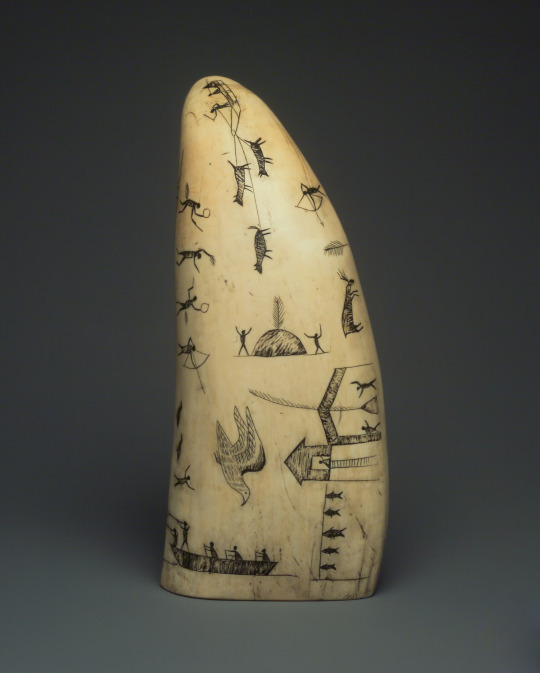
Climate in Crisis: Environmental Change in the Indigenous Americas
February 14, 2020–January 10, 2021
Arts of the Americas Galleries, 5th Floor
Climate change is having a severe impact on indigenous communities across the Americas, but this situation has an even longer history. The European conquest and colonization of the Americas beginning in the sixteenth century introduced ways of using and exploiting natural resources that clashed with indigenous ways of understanding and relating to the natural world. This exhibition draws upon the strength of our renowned collection to highlight indigenous worldviews about the environment, and the ongoing threat of ecological destruction.
The installation includes work spanning 2,800 years, and explores how indigenous beliefs, practices, and ways of living are impacted by the climate crisis, ranging from the effects of melting sea ice and overfishing for Native peoples of the Arctic and Pacific Northwest to illegal logging and deforestation for indigenous communities in the Amazon. This environmental perspective reveals the fundamental disparities between the misuse of natural resources over the past five hundred years and indigenous communities’ profound relationships with their ancestral homelands. In addition, the exhibition incorporates voices of contemporary indigenous activists to underscore the work being done today to counter the climate crisis and protect the planet.
Climate in Crisis: Environmental Change in the Indigenous Americas is curated by Nancy Rosoff, Andrew W. Mellon Senior Curator, Arts of the Americas, with Joseph Shaikewitz and Shea Spiller, Curatorial Assistants, Arts of the Americas and Europe.

African Arts—Global Conversations
February 14–November 15, 2020
Lobby Gallery, 1st Floor, and collection galleries on the 2nd, 3rd, and 5th Floors
African Arts—Global Conversations seeks to bring African arts into broader, deeper, and more meaningful and critical conversations about the ways that art history and encyclopedic museums have or have not included African artworks. It is the first exhibition of its kind to take a transcultural approach pairing diverse African works across mediums with objects made around the world―all drawn from our collection. It puts African and non-African arts from distinct places and time periods in dialogue with each other in an introductory gallery, as well as in “activation spaces” in the galleries dedicated to European Art, Arts of the Americas, American Art, Ancient Egyptian Art, and Arts of Asia. Duos, trios, and other groupings of objects from a wide variety of locations worldwide prompt conversations about history, art, race, power, design, and more. Approximately 33 artworks are presented (including 20 by African artists), as well as a selection of historical books. Highlights include the celebrated eighteenth-century sculpture of a Kuba ruler, a selection of fourteenth- to sixteenth-century Ethiopian Orthodox processional crosses, and a midtwentieth-century mask from Sierra Leone’s Ordehlay (Ode-Lay) society. Also on view are works by contemporary artists Atta Kwami, Ranti Bam, Magdalene Odundo OBE, and Taiye Idahor.
African Arts—Global Conversations is curated by Kristen Windmuller-Luna, Sills Family Consulting Curator, African Arts, Brooklyn Museum.

Studio 54: Night Magic
March 13–July 5, 2020
Morris A. and Meyer Schapiro Wing and Iris and B. Gerald Cantor Gallery, 5th Floor
Studio 54: Night Magic is the first exhibition to trace the groundbreaking aesthetics and social politics of the historic nightclub, and its lasting influence on nightclub design, cinema, and fashion. Though it was open for only three years—from April 26, 1977, to February 2, 1980—Studio 54 was arguably the most iconic nightclub to emerge in the twentieth century. Set in a former opera house in Midtown Manhattan, with the stage innovatively re-envisioned as a dance floor, Studio 54 became a space of sexual, gender, and creative liberation, where every patron could feel like a star. From the moment Studio 54 opened, its cutting-edge décor and state-of-the-art sound and lighting systems set it apart from other clubs at the time, attracting artists, fashion designers, musicians, and celebrities whose visits were vividly chronicled by notable photographers. In addition to presenting the photography and media that brought Studio 54 to global fame, the exhibition conveys the excitement of Manhattan’s storied disco club with more than 600 objects ranging from fashion design, drawings, paintings, film, and music to décor and extensive archives.
Studio 54: Night Magic is curated and designed by Matthew Yokobosky, Senior Curator of Fashion and Material Culture, Brooklyn Museum. Lead sponsorship for this exhibition is provided by Spotify.

John Edmonds: A Sidelong Glance
May 1, 2020–February 7, 2021
Stephanie and Tim Ingrassia Gallery of Contemporary Art, 4th Floor
John Edmonds is the first winner of the UOVO Prize, a new annual award for an emerging artist living or working in Brooklyn. This is Edmonds’s first solo museum exhibition and features approximately 25 new and recent photographic works that include portraiture and still lifes of Central and West African sculptures. Best known for his sensitive depictions of young Black men, Edmonds uses photography and video to create formal pictures that challenge art historical precedents and center Black queer desire. He often uses a large-format camera to heighten the staging of his subjects and explore their sculptural potential, making reference to religious paintings and modernist photography. Highlighting markers of Black self-fashioning and community— hoodies, du-rags, and more recently, African sculptures— Edmonds’s works point to individual style and a shared visual language across time.
John Edmonds: A Sidelong Glance is curated by Ashley James, former Assistant Curator, Contemporary Art, and Drew Sawyer, Phillip Leonian and Edith Rosenbaum Leonian Curator, Photography, Brooklyn Museum. Leadership support for the UOVO Prize is provided by UOVO.
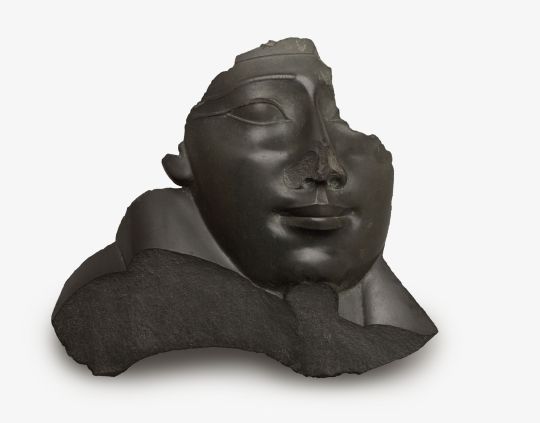
Striking Power: Iconoclasm in Ancient Egypt
Opening May 22, 2020
Egyptian Galleries, 3rd Floor
This exhibition, which draws from our renowned Egyptian collection, seeks to establish a context for considering contemporary concerns and struggles over public monuments and damage to antiquities. Striking Power: Iconoclasm in Ancient Egypt explores patterns of organized campaigns of destruction to sculptures and reliefs motivated by shifting ideologies, politics, and crime in ancient Egypt, over a 2,500-year period. Presenting approximately 60 whole and damaged masterpieces of Egyptian art, the exhibition explores the damage that occurred during and after the rule of Pharaohs, with particular focus on the contested reigns of Hatshepsut (circa 1478–1458 B.C.E.) and Akhenaten (circa 1353–1336 B.C.E.). Targeted damage to sculptures typically occurred around a figure’s nose, which ancient Egyptians believed would remove the sculpture’s supernatural ability to breathe and therefore prevent the deceased figure from interacting with the human world. The exhibition explores the notion of public approval of iconoclasm and poses the question, who has the power to bring down or destroy images? Opinions about iconoclasm hinge on questions of whose narrative dominates public space. Many of the same questions about public art that concern the contemporary world, such as the role that U.S. Confederate monuments should play in today’s publically shared spaces, are illuminated through the lens of ancient iconoclasm.
Striking Power: Iconoclasm in Ancient Egypt is organized in collaboration with the Pulitzer Arts Foundation and is curated by Edward Bleiberg, Senior Curator of Egyptian, Classical, and Ancient Near Eastern Art, Brooklyn Museum.

Lorraine O’Grady: Both/And
November 20, 2020–April 11, 2021
Elizabeth A. Sackler Center for Feminist Art, 4th Floor
Lorraine O’Grady: Both/And is the first comprehensive retrospective of one of the most significant figures in contemporary performance, conceptual, and feminist art. For four decades, from the anger and hilarity of the early guerrilla performance Mademoiselle Bourgeoise Noire, to the joy and complexity of Art Is… on Harlem’s streets, to the haunting alternations in her single-channel video Landscape (Western Hemisphere), O’Grady has delved fearlessly into a range of timely questions: Black subjectivity (especially Black female subjectivity), diaspora, hybridity, art’s guiding concepts and institutions (from modernism to the museum), and the intersection of self and history. By putting contradictory ideas into play—black and white, self and other, here and there, West and non-West, past and present—and allowing them to interact with each other without expecting a concrete resolution, O’Grady’s work aims to replace the dualistic, “either/or” of Western thought with a productive, open-ended “both/and.” The urgency of the ideas she explores is perhaps the reason that her work is being newly embraced by a younger generation of artists who find much to learn from a practice that upends the fixed positions of power that structure our culture—while bringing into focus the poignancy of the lives that have been lived within these frameworks.
The exhibition includes twelve of the artist’s fourteen major projects, accompanied by a selection of material from her rich archive. It is accompanied by a catalogue documenting the full span of O’Grady’s artistic career, the first publication to do so, with essays by Malik Gaines, Harry Burke, Zoe Whitley, Catherine Morris, and Aruna D’Souza, along with a conversation between O’Grady and Catherine Lord.
Lorraine O’Grady: Both/And is organized by Catherine Morris, Senior Curator for the Elizabeth A. Sackler Center for Feminist Art, Brooklyn Museum, and writer Aruna D’Souza. Leadership support for this exhibition is provided by The Kaleta A. Doolin Foundation. Major support is provided by the Elizabeth A. Sackler Museum Educational Trust. Generous support is provided by Shelley Fox Aarons and Philip Aarons.
We hope to see you at the Museum soon!
Illustrated, from top:
Rose Hartman (American, born 1937). Bianca Jagger Celebrating her Birthday, Studio 54, 1977. Black and white photograph. Courtesy of the artist. © Rose Hartman
Kehinde Wiley (American, born 1977). Napoleon Leading the Army over the Alps, 2005. Oil on canvas. Brooklyn Museum, Partial gift of Suzi and Andrew Booke Cohen in memory of Ilene R. Booke and in honor of Arnold L. Lehman, Mary Smith Dorward Fund, and William K. Jacobs, Jr. Fund, 2015.53. © Kehinde Wiley. (Photo: Brooklyn Museum)
Lourdes Grobet (born Mexico City, Mexico, 1940). Untitled, from the series Painted Landscapes, circa 1982. Silver dye bleach photograph. Brooklyn Museum; Gift of Marcuse Pfeifer, 1990.119.12. © Maria de Lourdes Grobet. (Photo: Brooklyn Museum)
Jeffrey Gibson (American, born 1972). WHEN FIRE IS APPLIED TO A STONE IT CRACKS, 2019. Acrylic on canvas, glass beads and artificial sinew inset into custom wood frame. Courtesy of the artist and Kavi Gupta, Chicago. © Jeffrey Gibson. (Photo: John Lusis)
Eskimo artist. Engraved Whale Tooth, late 19th century. Sperm whale tooth, black ash or graphite, oil. Brooklyn Museum; Gift of Robert B. Woodward, 20.895. Creative Commons-BY. (Photo: Brooklyn Museum)
Kuba artist. Mask (Mwaash aMbooy), late 19th or early 20th century. Rawhide, paint, plant fibers, textile, cowrie shells, glass, wood, monkey pelt, feathers. Brooklyn Museum; Robert B. Woodward Memorial Fund, 22.1582. (Photo: Brooklyn Museum)
Guy Marineau (French, born 1947). Pat Cleveland on the dance floor during Halston's disco bash at Studio 54, 1977. (Photo: Guy Marineau / WWD / Shutterstock)
John Edmonds (American, born 1989). Two Spirits, 2019. Archival pigment photograph. Courtesy of the artist and Company, New York. © John Edmonds
Face and Shoulder from an Anthropoid Sarcophagus, 332–30 B.C.E. Black basalt. Brooklyn Museum; Charles Edwin Wilbour Fund, 37.1516E. (Photo: Brooklyn Museum)
Lorraine O'Grady (American, born 1934). Rivers, First Draft: The Woman in the White Kitchen tastes her coconut, 1982/2015. Digital chromogenic print from Kodachrome 35mm slides in 48 parts. Courtesy Alexander Gray Associates, New York. © Lorraine O’Grady/Artists Rights Society (ARS), New York
#brooklyn#studio54bkm#studio54#Kehinde Wiley#DavidxWiley#feminist art#jeffrey gibson#globalconversations#climate change#indigeneous art#native american#native american art#african arts#bkmafricanarts#john edmonds#bkmegyptianart#egyptian art#lorraine o'grady#brooklyn museum#museums#nyc#art#exhibitions
77 notes
·
View notes
Photo
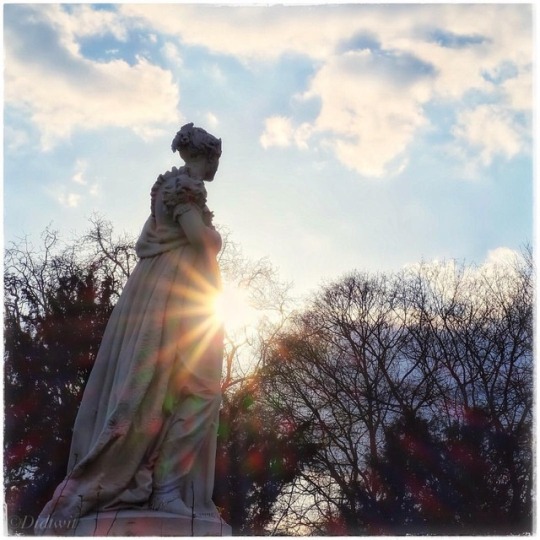
Mon image du soir ... Bonsoir 🌅 @villederueil 🌇 « Osez osez Joséphine Osez osez Joséphine Plus rien de s’oppose à la nuit Rien ne justifie » #alainbashung (à Château de Bois-Préau) https://www.instagram.com/p/Bvwf2fnHdki/?utm_source=ig_tumblr_share&igshid=194mtijyy18sl
0 notes
Text
#31 #მარტის ჩათვლით #ყოველი თვის #პირველ #კვირა #დღეს შეგიძლიათ #უფასოთ მოინახულოთ Ile de France-ში 👉🏻
- le #musée national du château de Compiègne
- le musée de #Fontainebleau
- le musée des Granges de #Port-Royal
- le musée #d’Archéologie nationale à Saint-Germain-en-Laye
- le musée du Domaine de #Versailles et du #Trianon, le #Château de Versailles
- le musée de la #Malmaison et du #Bois-Préau
- le musée de la #Céramique à #Sèvres
- le musée #départemental Albert-Kahn
- le maison d’Auguste #Rodin, villa des #Brillants, à #Meudon
- le musée des #Années 30, #espace #Landowski à #Boulogne,
- le musée #national de la #Renaissance à #Écouen
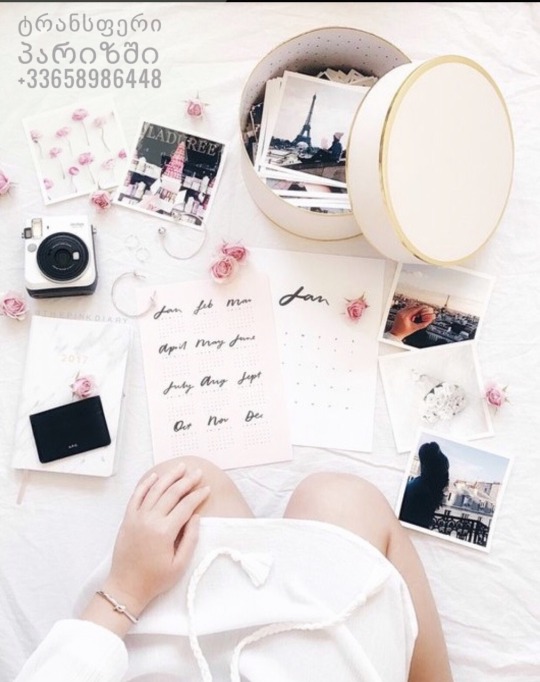
0 notes
Text
New Post has been published on Lutars Turizm
New Post has been published on https://www.lutarsturizm.com/paris-muzeleri-bileti-2-4-veya-6-gunluk.html
Paris Müzeleri Bileti: 2, 4 veya 6 Günlük
Kullanışlı ve ekonomik Paris Müzeleri Bileti ile Paris ve çevresindeki 60’tan fazla başlıca müze ve anıtı ziyaret edin. Louvre ile Versay’ı keşfedin ve Zafer Takı, Pompidou Merkezi ve çok daha fazlasını ziyaret edin.
Paris Müzeleri Bileti: 2, 4 veya 6 Günlük
Öne çıkanlar
Paris ve çevresindeki 60’tan fazla müze ve anıta ücretsiz girişin keyfini çıkarın
Şehrin en popüler müzelerine öncelikli giriş hakkından doyasıya yararlanın
2, 4 veya 6 gün geçerli bir bilet arasından seçim yapın
Tam açıklama
Louvre Müzesi, Orsay Müzesi ve Pompidou Merkezi de dahil olmak üzere, Paris ve çevresindeki 60’tan fazla müze ve anıta sıra beklemeden, öncelikli erişimin keyfini çıkarın.
Bilet; 2, 4 veya 6 gün için geçerlidir ve Louvre’dan sadece 10 dakikalık yürüme mesafesindeki, rahatlıkla ulaşılabilecek bir teslim noktasından alınabilir.
Bilet, çok sayıda etkinliğe, turistik yere ve müzeye ücretsiz giriş ayrıcalığı sağlar.
Paris’te:
Zafer Takı
Musée de l’Armée
Tombeau de Napoléon 1er
Pompidou Merkezi
Musée National d’Art Moderne
Musée national des Arts asiatiques
Guimet
Les Arts décoratifs
Musée des Arts et métiers
Musée de l’Assistance Publique, Hôpitaux de Paris
Musée du quai Branly
Musée Picasso Paris
Chapelle expiatoire
La Cinémathèque française
Musée du Cinéma
Cité des Sciences et de l’Industrie
Conciergerie
Musée national Eugène Delacroix
Musée des Égouts de Paris
Musée du Louvre – Musée national de la Marine
Musée de la Monnaie
Cité de l’Architecture et du Patrimoine
Musée national des Monuments français
Musée Gustave Moreau
Musée national du Moyen Âge, Thermes et hôtel de Cluny
Cité de la Musique, Musée de la Musique
Crypte archéologique de Notre-Dame
Tours de Notre-Dame
Musée national de l’Orangerie
Musée de l’Ordre de la Libération
Musée d’Orsay
Panthéon
Musée des Plans-reliefs
Musée de la Poste
Musée Rodin
Sainte-Chapelle
Paris dışında:
Musée de l’Air et de l’Espace
Musée d’Archéologie nationale de Saint-Germain-en-Laye
Musée national de la Céramique de Sèvres
Chaalis Kraliyet Manastırı
Musée et domaine nationaux du Château de Compiègne
Musée Condé, Château de Chantilly
Musée départemental Maurice Denis
Fontainebleau Şatosu
Château de Maisons-Laffitte
Musée national des Châteaux de Malmaison et Bois-Préau
Château de Pierrefonds
National Museum of Port Royal Granges
Château de Rambouillet
Musée national de la Renaissance
Château d’Ecouen
Maison d’Auguste Rodin à Meudon
Saint-Denis Bazilikası
Villa Savoye
Musée national des Châteaux de Versailles et de Trianon
Vincennes Şatosu
Neler dahil?
2, 4, veya 6 günlük Paris Müzeleri Bileti
Nehirde tekne gezisi (seçenek tercih edildiyse)
Müzelerdeki kalıcı sergilere erişim
Haftanın 7 günü hizmet sunan, bilet teslim ve danışma servisi
0 notes
Text
New Post has been published on Lutars Turizm
New Post has been published on https://www.lutarsturizm.com/paris-muzeleri-bileti-2-4-veya-6-gunluk.html
Paris Müzeleri Bileti: 2, 4 veya 6 Günlük
Kullanışlı ve ekonomik Paris Müzeleri Bileti ile Paris ve çevresindeki 60’tan fazla başlıca müze ve anıtı ziyaret edin. Louvre ile Versay’ı keşfedin ve Zafer Takı, Pompidou Merkezi ve çok daha fazlasını ziyaret edin.
Paris Müzeleri Bileti: 2, 4 veya 6 Günlük
Öne çıkanlar
Paris ve çevresindeki 60’tan fazla müze ve anıta ücretsiz girişin keyfini çıkarın
Şehrin en popüler müzelerine öncelikli giriş hakkından doyasıya yararlanın
2, 4 veya 6 gün geçerli bir bilet arasından seçim yapın
Tam açıklama
Louvre Müzesi, Orsay Müzesi ve Pompidou Merkezi de dahil olmak üzere, Paris ve çevresindeki 60’tan fazla müze ve anıta sıra beklemeden, öncelikli erişimin keyfini çıkarın.
Bilet; 2, 4 veya 6 gün için geçerlidir ve Louvre’dan sadece 10 dakikalık yürüme mesafesindeki, rahatlıkla ulaşılabilecek bir teslim noktasından alınabilir.
Bilet, çok sayıda etkinliğe, turistik yere ve müzeye ücretsiz giriş ayrıcalığı sağlar.
Paris’te:
Zafer Takı
Musée de l’Armée
Tombeau de Napoléon 1er
Pompidou Merkezi
Musée National d’Art Moderne
Musée national des Arts asiatiques
Guimet
Les Arts décoratifs
Musée des Arts et métiers
Musée de l’Assistance Publique, Hôpitaux de Paris
Musée du quai Branly
Musée Picasso Paris
Chapelle expiatoire
La Cinémathèque française
Musée du Cinéma
Cité des Sciences et de l’Industrie
Conciergerie
Musée national Eugène Delacroix
Musée des Égouts de Paris
Musée du Louvre – Musée national de la Marine
Musée de la Monnaie
Cité de l’Architecture et du Patrimoine
Musée national des Monuments français
Musée Gustave Moreau
Musée national du Moyen Âge, Thermes et hôtel de Cluny
Cité de la Musique, Musée de la Musique
Crypte archéologique de Notre-Dame
Tours de Notre-Dame
Musée national de l’Orangerie
Musée de l’Ordre de la Libération
Musée d’Orsay
Panthéon
Musée des Plans-reliefs
Musée de la Poste
Musée Rodin
Sainte-Chapelle
Paris dışında:
Musée de l’Air et de l’Espace
Musée d’Archéologie nationale de Saint-Germain-en-Laye
Musée national de la Céramique de Sèvres
Chaalis Kraliyet Manastırı
Musée et domaine nationaux du Château de Compiègne
Musée Condé, Château de Chantilly
Musée départemental Maurice Denis
Fontainebleau Şatosu
Château de Maisons-Laffitte
Musée national des Châteaux de Malmaison et Bois-Préau
Château de Pierrefonds
National Museum of Port Royal Granges
Château de Rambouillet
Musée national de la Renaissance
Château d’Ecouen
Maison d’Auguste Rodin à Meudon
Saint-Denis Bazilikası
Villa Savoye
Musée national des Châteaux de Versailles et de Trianon
Vincennes Şatosu
Neler dahil?
2, 4, veya 6 günlük Paris Müzeleri Bileti
Nehirde tekne gezisi (seçenek tercih edildiyse)
Müzelerdeki kalıcı sergilere erişim
Haftanın 7 günü hizmet sunan, bilet teslim ve danışma servisi
0 notes
Text
New Post has been published on Lutars Turizm
New Post has been published on https://www.lutarsturizm.com/paris-muzeleri-bileti-2-4-veya-6-gunluk.html
Paris Müzeleri Bileti: 2, 4 veya 6 Günlük
Kullanışlı ve ekonomik Paris Müzeleri Bileti ile Paris ve çevresindeki 60’tan fazla başlıca müze ve anıtı ziyaret edin. Louvre ile Versay’ı keşfedin ve Zafer Takı, Pompidou Merkezi ve çok daha fazlasını ziyaret edin.
Paris Müzeleri Bileti: 2, 4 veya 6 Günlük
Öne çıkanlar
Paris ve çevresindeki 60’tan fazla müze ve anıta ücretsiz girişin keyfini çıkarın
Şehrin en popüler müzelerine öncelikli giriş hakkından doyasıya yararlanın
2, 4 veya 6 gün geçerli bir bilet arasından seçim yapın
Tam açıklama
Louvre Müzesi, Orsay Müzesi ve Pompidou Merkezi de dahil olmak üzere, Paris ve çevresindeki 60’tan fazla müze ve anıta sıra beklemeden, öncelikli erişimin keyfini çıkarın.
Bilet; 2, 4 veya 6 gün için geçerlidir ve Louvre’dan sadece 10 dakikalık yürüme mesafesindeki, rahatlıkla ulaşılabilecek bir teslim noktasından alınabilir.
Bilet, çok sayıda etkinliğe, turistik yere ve müzeye ücretsiz giriş ayrıcalığı sağlar.
Paris’te:
Zafer Takı
Musée de l’Armée
Tombeau de Napoléon 1er
Pompidou Merkezi
Musée National d’Art Moderne
Musée national des Arts asiatiques
Guimet
Les Arts décoratifs
Musée des Arts et métiers
Musée de l’Assistance Publique, Hôpitaux de Paris
Musée du quai Branly
Musée Picasso Paris
Chapelle expiatoire
La Cinémathèque française
Musée du Cinéma
Cité des Sciences et de l’Industrie
Conciergerie
Musée national Eugène Delacroix
Musée des Égouts de Paris
Musée du Louvre – Musée national de la Marine
Musée de la Monnaie
Cité de l’Architecture et du Patrimoine
Musée national des Monuments français
Musée Gustave Moreau
Musée national du Moyen Âge, Thermes et hôtel de Cluny
Cité de la Musique, Musée de la Musique
Crypte archéologique de Notre-Dame
Tours de Notre-Dame
Musée national de l’Orangerie
Musée de l’Ordre de la Libération
Musée d’Orsay
Panthéon
Musée des Plans-reliefs
Musée de la Poste
Musée Rodin
Sainte-Chapelle
Paris dışında:
Musée de l’Air et de l’Espace
Musée d’Archéologie nationale de Saint-Germain-en-Laye
Musée national de la Céramique de Sèvres
Chaalis Kraliyet Manastırı
Musée et domaine nationaux du Château de Compiègne
Musée Condé, Château de Chantilly
Musée départemental Maurice Denis
Fontainebleau Şatosu
Château de Maisons-Laffitte
Musée national des Châteaux de Malmaison et Bois-Préau
Château de Pierrefonds
National Museum of Port Royal Granges
Château de Rambouillet
Musée national de la Renaissance
Château d’Ecouen
Maison d’Auguste Rodin à Meudon
Saint-Denis Bazilikası
Villa Savoye
Musée national des Châteaux de Versailles et de Trianon
Vincennes Şatosu
Neler dahil?
2, 4, veya 6 günlük Paris Müzeleri Bileti
Nehirde tekne gezisi (seçenek tercih edildiyse)
Müzelerdeki kalıcı sergilere erişim
Haftanın 7 günü hizmet sunan, bilet teslim ve danışma servisi
0 notes
Text

Statue of Napoleon as a School Boy
Opening at the Château de Bois-Préau of the exhibition “1769 Corsica at the birth of Napoleon Bonaparte” curated by Elisabeth Caude with Jean-marc Olivesi and Odile Bianco
Credit: David Chanteranne
#so cute#Napoleon#napoleon bonaparte#18th century#napoleonic era#napoleonic#Corsica#corse#la corse#Château#Château de Bois-Préau#bois-préau#malmaison#château de malmaison#young Napoleon#1700s#France#historian#napoleonic historian
28 notes
·
View notes
Text
New Post has been published on Lutars Turizm
New Post has been published on https://www.lutarsturizm.com/paris-muzeleri-bileti-2-4-veya-6-gunluk.html
Paris Müzeleri Bileti: 2, 4 veya 6 Günlük
Kullanışlı ve ekonomik Paris Müzeleri Bileti ile Paris ve çevresindeki 60’tan fazla başlıca müze ve anıtı ziyaret edin. Louvre ile Versay’ı keşfedin ve Zafer Takı, Pompidou Merkezi ve çok daha fazlasını ziyaret edin.
Paris Müzeleri Bileti: 2, 4 veya 6 Günlük
Öne çıkanlar
Paris ve çevresindeki 60’tan fazla müze ve anıta ücretsiz girişin keyfini çıkarın
Şehrin en popüler müzelerine öncelikli giriş hakkından doyasıya yararlanın
2, 4 veya 6 gün geçerli bir bilet arasından seçim yapın
Tam açıklama
Louvre Müzesi, Orsay Müzesi ve Pompidou Merkezi de dahil olmak üzere, Paris ve çevresindeki 60’tan fazla müze ve anıta sıra beklemeden, öncelikli erişimin keyfini çıkarın.
Bilet; 2, 4 veya 6 gün için geçerlidir ve Louvre’dan sadece 10 dakikalık yürüme mesafesindeki, rahatlıkla ulaşılabilecek bir teslim noktasından alınabilir.
Bilet, çok sayıda etkinliğe, turistik yere ve müzeye ücretsiz giriş ayrıcalığı sağlar.
Paris’te:
Zafer Takı
Musée de l’Armée
Tombeau de Napoléon 1er
Pompidou Merkezi
Musée National d’Art Moderne
Musée national des Arts asiatiques
Guimet
Les Arts décoratifs
Musée des Arts et métiers
Musée de l’Assistance Publique, Hôpitaux de Paris
Musée du quai Branly
Musée Picasso Paris
Chapelle expiatoire
La Cinémathèque française
Musée du Cinéma
Cité des Sciences et de l’Industrie
Conciergerie
Musée national Eugène Delacroix
Musée des Égouts de Paris
Musée du Louvre – Musée national de la Marine
Musée de la Monnaie
Cité de l’Architecture et du Patrimoine
Musée national des Monuments français
Musée Gustave Moreau
Musée national du Moyen Âge, Thermes et hôtel de Cluny
Cité de la Musique, Musée de la Musique
Crypte archéologique de Notre-Dame
Tours de Notre-Dame
Musée national de l’Orangerie
Musée de l’Ordre de la Libération
Musée d’Orsay
Panthéon
Musée des Plans-reliefs
Musée de la Poste
Musée Rodin
Sainte-Chapelle
Paris dışında:
Musée de l’Air et de l’Espace
Musée d’Archéologie nationale de Saint-Germain-en-Laye
Musée national de la Céramique de Sèvres
Chaalis Kraliyet Manastırı
Musée et domaine nationaux du Château de Compiègne
Musée Condé, Château de Chantilly
Musée départemental Maurice Denis
Fontainebleau Şatosu
Château de Maisons-Laffitte
Musée national des Châteaux de Malmaison et Bois-Préau
Château de Pierrefonds
National Museum of Port Royal Granges
Château de Rambouillet
Musée national de la Renaissance
Château d’Ecouen
Maison d’Auguste Rodin à Meudon
Saint-Denis Bazilikası
Villa Savoye
Musée national des Châteaux de Versailles et de Trianon
Vincennes Şatosu
Neler dahil?
2, 4, veya 6 günlük Paris Müzeleri Bileti
Nehirde tekne gezisi (seçenek tercih edildiyse)
Müzelerdeki kalıcı sergilere erişim
Haftanın 7 günü hizmet sunan, bilet teslim ve danışma servisi
0 notes
Text
Paris Müzeleri Bileti: 2, 4 veya 6 Günlük - Lutars Turizm
New Post has been published on https://www.lutarsturizm.com/paris-muzeleri-bileti-2-4-veya-6-gunluk.html
Paris Müzeleri Bileti: 2, 4 veya 6 Günlük
Kullanışlı ve ekonomik Paris Müzeleri Bileti ile Paris ve çevresindeki 60’tan fazla başlıca müze ve anıtı ziyaret edin. Louvre ile Versay’ı keşfedin ve Zafer Takı, Pompidou Merkezi ve çok daha fazlasını ziyaret edin.
Paris Müzeleri Bileti: 2, 4 veya 6 Günlük
Öne çıkanlar
Paris ve çevresindeki 60’tan fazla müze ve anıta ücretsiz girişin keyfini çıkarın
Şehrin en popüler müzelerine öncelikli giriş hakkından doyasıya yararlanın
2, 4 veya 6 gün geçerli bir bilet aras��ndan seçim yapın
Tam açıklama
Louvre Müzesi, Orsay Müzesi ve Pompidou Merkezi de dahil olmak üzere, Paris ve çevresindeki 60’tan fazla müze ve anıta sıra beklemeden, öncelikli erişimin keyfini çıkarın.
Bilet; 2, 4 veya 6 gün için geçerlidir ve Louvre’dan sadece 10 dakikalık yürüme mesafesindeki, rahatlıkla ulaşılabilecek bir teslim noktasından alınabilir.
Bilet, çok sayıda etkinliğe, turistik yere ve müzeye ücretsiz giriş ayrıcalığı sağlar.
Paris’te:
Zafer Takı
Musée de l’Armée
Tombeau de Napoléon 1er
Pompidou Merkezi
Musée National d’Art Moderne
Musée national des Arts asiatiques
Guimet
Les Arts décoratifs
Musée des Arts et métiers
Musée de l’Assistance Publique, Hôpitaux de Paris
Musée du quai Branly
Musée Picasso Paris
Chapelle expiatoire
La Cinémathèque française
Musée du Cinéma
Cité des Sciences et de l’Industrie
Conciergerie
Musée national Eugène Delacroix
Musée des Égouts de Paris
Musée du Louvre – Musée national de la Marine
Musée de la Monnaie
Cité de l’Architecture et du Patrimoine
Musée national des Monuments français
Musée Gustave Moreau
Musée national du Moyen Âge, Thermes et hôtel de Cluny
Cité de la Musique, Musée de la Musique
Crypte archéologique de Notre-Dame
Tours de Notre-Dame
Musée national de l’Orangerie
Musée de l’Ordre de la Libération
Musée d’Orsay
Panthéon
Musée des Plans-reliefs
Musée de la Poste
Musée Rodin
Sainte-Chapelle
Paris dışında:
Musée de l’Air et de l’Espace
Musée d’Archéologie nationale de Saint-Germain-en-Laye
Musée national de la Céramique de Sèvres
Chaalis Kraliyet Manastırı
Musée et domaine nationaux du Château de Compiègne
Musée Condé, Château de Chantilly
Musée départemental Maurice Denis
Fontainebleau Şatosu
Château de Maisons-Laffitte
Musée national des Châteaux de Malmaison et Bois-Préau
Château de Pierrefonds
National Museum of Port Royal Granges
Château de Rambouillet
Musée national de la Renaissance
Château d’Ecouen
Maison d’Auguste Rodin à Meudon
Saint-Denis Bazilikası
Villa Savoye
Musée national des Châteaux de Versailles et de Trianon
Vincennes Şatosu
Neler dahil?
2, 4, veya 6 günlük Paris Müzeleri Bileti
Nehirde tekne gezisi (seçenek tercih edildiyse)
Müzelerdeki kalıcı sergilere erişim
Haftanın 7 günü hizmet sunan, bilet teslim ve danışma servisi
0 notes
Link
Only eight kilometers west of Paris, Rueil-Malmaison is an affluent and leafy suburb loaded with French imperial history.
That's where you can get to know Joséphine de Beauharnais better, Napoleon's wife until they divorced in 1810. You’ll discover the palatial home that she shared with the Emperor, wander the spacious grounds around it and pay your respects at the church containing her tomb. Rueil-Malmaison is practically overrun with green space, in its fine gardens, deep forests and on the verdant banks of the Seine. So if you’re in search of a serene home from home on a trip to Paris with its own share of sights, Rueil-Malmaison would be a great option. Let's explore the best things to do in Rueil-Malmaison.
[toc]
1. Château de Malmaison
Joséphine acquired the Château de Malmaison in 1799 and over the next few years spent astronomical money to improve the house and enrich the base. Between 1800 and 1802 it was even a seat of the French government.
Joséphine meanwhile lavished most of her attention on the gardens, planting 250 varieties of rose and setting up a menagerie with zebras, llamas, antelopes, and kangaroos. Later, following her death and the defeat at Waterloo, Napoleon stayed here during the 100 days before going into exile.
It’s a marvelous property, drenched in the history of this charismatic family. The interior is a museum with sumptuous decor, furniture, musical instruments and Sèvres dinnerware belonging to Joséphine and Napoleon.
2. Bois-Préau
From the day Joséphine bought Château de Malmaison she had her eye on this neighboring property.
But the banker’s daughter who owned it refused to sell, and Joséphine wouldn’t get hold of it until the neighbor was found drowned in the pond in 1808. These 17 hectares are now a gorgeous public park in the English style with generous lawns and mature trees like the Turkish hazels that have been here since Joséphine’s time.
There’s a statue of the empress by the eminent 19th-century sculptor Vital-Dubray, and the stage is set by the 18th-century Château de Bois-Préau, which contains a Napoleon museum currently closed for renovations.
3. Château de la Petite Malmaison
When the Château de Malmaison’s enormous grounds were divided up this sumptuous pavilion became a separate property and so is now a distinct attraction. It was built in 1805 by Louis-Martin Berthault, who would go on to design Joséphine’s tomb.
The Empress was deeply involved in the work because it went hand-in-hand with her passion for botany, and one wing of the building was taken up by a hothouse for growing rare tropical plants.
On a visit, you’ll learn about the explorer and botanist, Aimé Bonpland who brought back all of these plants from his travels. It is also a second home for artist Pierre-Joseph Redouté, who described the Joséphine rose as still popular as postcards today.
4. Église Saint-Pierre-Saint-Paul
This solemn Renaissance church is best known for housing the tombs of Joséphine and her daughter Hortense. Joséphine’s funeral was held here on 2 June 1814, and her tomb would be completed 11 years later in 1825.
It was a joint effort between architect Louis-Martin Berthault and sculptor Pierre Cartelier and carved from Carrara marble. Hortense was Joséphine’s daughter from a previous marriage (her former husband was killed in the Revolution), and she went on to marry Napoleon’s brother, Louis Bonaparte.
Hortense died in 1837, and her resplendent mausoleum was inaugurated by her son, Napoleon III in 1858.
5. Bois de Saint-Cucufa
The bulk of the Malmaison grounds is a 200-hectare forest, which was finally bought by the state in 1871 to become a public park. There’s some Joséphine trivia here too because it was after a walk on a cold night beside the park’s pond that she contracted pneumonia that caused her death.
There’s now a two-kilometer interpretation trail informing you about the park’s history, as well as bike trails and of course that large pond, which is more than two hectares in size. So you can visit for a jog, easy stroll or take a picnic by the water.
6. Mont-Valérien
In 1841 Paris invested in a ring of artillery fortifications to prepare for an attack from what is now Germany.
This fortress atop Mont-Valérien, the main rise to the west of Paris, was involved during the Siege of Paris in 1870 and the fight to suppress the Paris Commune in 1871. But its darkest days came during the Second World War when more than a thousand members of the French Resistance and other prohibited groups were executed here.
Later the site was preserved by Charles de Gaulle as a war memorial with an eternal flame and a trail retracing the final steps of these fighters, as well as a chapel with graffiti by condemned men.
7. Musée d’Histoire Locale
The old town hall is the home for a museum that covers the history of the city, including some of the ways of life and personalities that might otherwise be forgotten. For instance, there are details about Rueil-Malmaison’s old winemaking industry, which was killed off by the phylloxera blight at the end of the 1800s.
You can also get perspectives about the Franco-Prussian War and the Siege of Paris, and if you have any lingering curiosity about Empress Joséphine you can indulge it here. Also from the Napoleonic era is a set of 1,600 figurines representing the Emperor’s Grand Army.
Finally, there’s a whole room dedicated to Édouard Belin, whose Belinograph from 1913 was the predecessor to the wire photo, capable of sending images down phone lines, long before the invention of the fax.
8. Musée des Gardes Suisses
The Swiss Guard was a corps of Swiss mercenaries founded by Louis XIII in 1616 and tasked with protecting the king.
These soldiers were renowned for their loyalty, and during the Revolution, almost 900 were massacred attempting to defend the Tuileries in 1792. This museum is in one of the three barracks built for the corps in the middle of the 18th century, and every week a detachment would leave this building for Versailles to relieve the “piquet d’honneur ” there.
The building is recognized as a French “historic monument” and has uniforms, documents and other memorabilia relating to the corps.
9. Parc de Saint-Cloud
If Rueil-Malmaison is all about the empire, the neighboring suburb of Saint-Cloud has a Royal flavor. You can see this legacy at the Parc de Saint-Cloud, which is a prestigious French “Jardin Notable” and praised as one of Europe’s loveliest gardens.
On top of that, there’s a view of Paris that will knock your socks off from the La Lanterne lookout, with the Eiffel Tower and Sacré-Cœur rippling on a clear summer’s day.
And as for royalty, the park used to be the grounds for the Château de Saint-Cloud, a royal palace destroyed during the Siege of Paris in 1870. Marie Antoinette had been especially fond of the house and planted the flower garden that is still there today.
10. Atelier Grognard
This building is a curious 19th-century factory that once forged thousands of copper, zinc and tin plates for engraving.
Those days are long gone, and the two large halls in the Atelier Grognard are now an evocative venue for temporary art exhibitions.
You should find out what’s on when you come to Rueil-Malmaison because the art is high-quality: In recent years, there have been inscriptions of Dubuffet, sculptures of Miró, Impressive works of the Seine, Abstract Expressionism from the 50s and works of the famous Welsh family.
More ideals for you: Top 10 things to do in Roubaix
From : https://wikitopx.com/travel/top-10-things-to-do-in-rueil-malmaison-709662.html
0 notes
Text
Nos réalisations
Charpente traditionnelle, Construction ossature bois, Bardage, Création de terrasse, Création de préau, Ambillou-Château, Saumur, ...
Source :http://feeds.feedblitz.com/~/488986436/0/devisartisancharpente
0 notes
Text
Nos réalisations
Charpente traditionnelle, Construction ossature bois, Bardage, Création de terrasse, Création de préau, Ambillou-Château, Saumur, ...
Source : http://bit.ly/2zIYDAj
0 notes